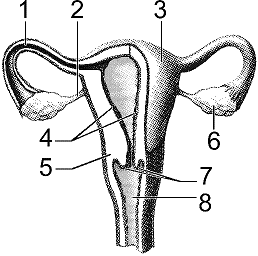Refer to Figure 50-3. The cervix is labeled:

a. 3
b. 4
c. 5
d. 7
e. 8
D
You might also like to view...
In 2006, the greatest use of energy in the United States was _____
1.nuclear energy going to industry 2.natural gas for residential and commercial uses 3.petroleum used for transportation 4.petroleum used in industry
Species that have a delayed reproductive stage, are competing for limited resources, and have smaller numbers of slowly maturing large offspring show ________________ adaptations.
A. K-selected B. r-selected
In vertebrates, the family of myogenic regulatory factors (MRFs) plays a major role in muscle development. This family consists of four related genes which have distinct but overlapping functions. This gene family is represented by only a single gene in Drosophila, called nautilus. You want to know whether nautilus plays a role like all of the MRFs put together, or more like one in particular. What is a quick and easy way to begin to address this question?
A. Generate four transgenic Drosophila strains that express the MRFs in a mutant nautilus background. B. Use a DNA microarray to compare gene activation patterns between nautilus and the MRFs. C. Compare the DNA and protein sequences of all the genes to determine if nautilus is more similar to one MRF than another. D. Compare the proteome of a cell expressing nautilus to the those of cells expressing each of the MRFs in turn.
Why is refrigeration a considered short-term method of storing bacteria?
A. Refrigeration slows metabolism but does not stop it. B. Refrigeration causes cellular damage. C. Refrigeration dehydrates cells. D. Refrigeration does not slow metabolism. E. None of these, refrigeration is not a suitable storage method for bacterial